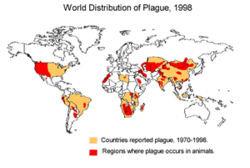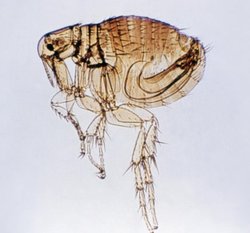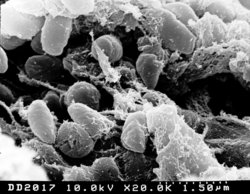Plague
Contents
- 1 Introduction (Plague)
- 1.1 U.S. Geological Survey
- 1.2 Centers for Disease Control and Prevention
- 1.2.1 Risk
- 1.2.2 Questions and Answers About Plague
- 1.2.2.1 How is plague transmitted?
- 1.2.2.2 How do people get plague?
- 1.2.2.3 What is the basic transmission cycle?
- 1.2.2.4 Could you get plague from another person?
- 1.2.2.5 What are the signs and symptoms of plague?
- 1.2.2.6 What is the incubation period for plague?
- 1.2.2.7 What is the mortality rate of plague?
- 1.2.2.8 How many cases of plague occur in the U.S.?
- 1.2.2.9 How is plague treated?
- 1.2.2.10 Is the disease seasonal in its occurrence?
- 1.2.2.11 Where is plague most common?
- 1.2.2.12 Who is at risk for getting plague?
- 2 References
- 3 Further Reading
Introduction (Plague)
U.S. Geological Survey
Wildlife Health Connection to Emerging Infectious Diseases
"Wildlife, domestic animals and humans share a large and increasing number of infectious diseases. The continued globalization of society, human population growth, and associated landscape changes will further enhance interfaces between wildlife, domestic animals, and humans, thereby facilitating additional infectious disease emergence. These interfaces are such that a century-old concept of “the one medicine” is receiving greater attention because of the need to address these diseases across species if their economic, social, and other impacts are to be effectively minimized. The wildlife component of this triad has received inadequate focus in the past to effectively protect human health as evidence by such contemporary diseases as SARS, Lyme disease, West Nile Fever, and a host of other emerging diseases. Further, habitat loss and other factors associated with human-induced landscape changes have reduced past ability for many wildlife populations to overcome losses due to various causes. This, disease emergence and resurgence has reached unprecedented importance for the sustainability of desired population levels for many wildlife populations and for the long-term survival of some species"[1]
Centers for Disease Control and Prevention
Plague is an infectious disease of animals and humans caused by a bacterium named Yersinia pestis. People usually get plague from being bitten by a rodent's flea that is carrying the plague bacterium or by handling an infected animal. Millions of people in Europe died from plague in the Middle Ages, when human homes and places of work were inhabited by flea-infested rats. Today, modern antibiotics are effective against plague, but if an infected person is not treated promptly, the disease is likely to cause illness or death.
Risk
 World Distribution of Plague, 1998. (Source: Centers for Disease Control and Prevention)
World Distribution of Plague, 1998. (Source: Centers for Disease Control and Prevention) Wild rodents in certain areas around the world are infected with plague. Outbreaks in people still occur in rural communities or in cities. They are usually associated with infected rats and rat fleas that live in the home. In the United States, the last urban plague epidemic occurred in Los Angeles in 1924-25. Since then, human plague in the United States has occurred as mostly scattered cases in rural areas (an average of 10 to 15 persons each year). Globally, the World Health Organization reports 1,000 to 3,000 cases of plague every year. In North America, plague is found in certain animals and their fleas from the Pacific Coast to the Great Plains, and from southwestern Canada to Mexico. Most human cases in the United States occur in two regions: 1) northern New Mexico, northern Arizona, and southern Colorado; and 2) California, southern Oregon, and far western Nevada. Plague also exists in Africa, Asia, and South America (see map).
Questions and Answers About Plague
How is plague transmitted?
 Flea, Vector of Yersinia pestis (Plague). (Source: Centers for Disease Control and Prevention)
Flea, Vector of Yersinia pestis (Plague). (Source: Centers for Disease Control and Prevention) By fleas that become infected with bacteria Yersinia pestis that cause plague.
How do people get plague?
By the bite of fleas infected with the plague bacteria.
Prairie dogs can harbor fleas infected with plague bacteria.
What is the basic transmission cycle?
Fleas become infected by feeding on rodents, such as the chipmunks, prairie dogs, ground squirrels, mice, and other mammals that are infected with the bacteria Yersinia pestis. Fleas transmit the plague bacteria to humans and other mammals during the feeding process. The plague bacteria are maintained in the blood systems of rodents.
Could you get plague from another person?
 Scanning electron micrograph, Yersinia pestis (Plague). (Source: National Institutes of Health / NIAID)
Scanning electron micrograph, Yersinia pestis (Plague). (Source: National Institutes of Health / NIAID) Yes, when the other person has plague pneumonia and coughs droplets containing the plague bacteria into air that is breathed by a non-infected person.
What are the signs and symptoms of plague?
The typical sign of the most common form of human plague is a swollen and very tender lymph gland, accompanied by pain. The swollen gland is called a "bubo" (hence the term "bubonic plague"). Bubonic plague should be suspected when a person develops a swollen gland, fever, chills, headache, and extreme exhaustion, and has a history of possible exposure to infected rodents, rabbits, or fleas.
What is the incubation period for plague?
 Prairie dogs can harbor fleas infected with the bacteria that causes plague. (Source: Centers for Disease Control and Prevention)
Prairie dogs can harbor fleas infected with the bacteria that causes plague. (Source: Centers for Disease Control and Prevention) A person usually becomes ill with bubonic plague 2 to 6 days after being infected. When bubonic plague is left untreated, plague bacteria invade the bloodstream. When plague bacteria multiply in the bloodstream, they spread rapidly throughout the body and cause a severe and often fatal condition. Infection of the lungs with the plague bacterium causes the pneumonic form of plague, a severe respiratory illness. The infected person may experience high fever, chills, cough, and breathing difficulty, and expel bloody sputum. If plague patients are not given specific antibiotic therapy, the disease can progress rapidly to death.
What is the mortality rate of plague?
About 14% (1 in 7) of all plague cases in the United States are fatal.
How many cases of plague occur in the U.S.?
Human plague in the United States has occurred as mostly scattered cases in rural areas (an average of 10 to 20 persons each year). Globally, the World Health Organization reports 1,000 to 3,000 cases of plague every year.
How is plague treated?
 Reported Human Plague by County, 1970-1999. (Source: Centers for Disease Control and Prevention)
Reported Human Plague by County, 1970-1999. (Source: Centers for Disease Control and Prevention) According to treatment experts, a patient diagnosed with suspected plague should be hospitalized and medically isolated. Laboratory tests should be done, including blood cultures for plague bacteria and microscopic examination of lymph gland, blood, and sputum samples. Antibiotic treatment should begin as soon as possible after laboratory specimens are taken. Streptomycin is the antibiotic of choice. Gentamicin is used when streptomycin is not available. Tetracyclines and chloramphenicol are also effective. Persons who have been in close contact with a plague patient, particularly a patient with plague pneumonia, should be identified and evaluated. The U.S. Public Health Service requires that all cases of suspected plague be reported immediately to local and state health departments and that the diagnosis be confirmed by CDC. As required by the International Health Regulations, CDC reports all U.S. plague cases to the World Health Organization.
Is the disease seasonal in its occurrence?
No, plague can be acquired at anytime during the year.
Where is plague most common?
Reported cases of human plague, western U.S. map, 1970-97 A. Click on the map at right that shows reported cases of human plague between 1970-1997 by patient's county of residence. Generally, plague is most common in the southwestern states, particularly New Mexico and Arizona.
Who is at risk for getting plague?
Outbreaks in people occur in areas where housing and sanitation conditions are poor. These outbreaks can occur in rural communities or in cities. They are usually associated with infected rats and rat fleas that live in the home.
References
^ Milton Friend, USGS Emeritus Scientist. Founding Director, USGS National Wildlife Health Center.